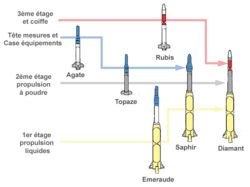Engineering:Saphir (rocket)
 A diagram of the Saphir rocket | |
| Manufacturer | SEREB |
|---|---|
| Country of origin | France |
| Size | |
| Height | 17.77 metres (58.3 ft) |
| Diameter | 1.40 metres (4 ft 7 in) |
| Mass | 18,058 kilograms (39,811 lb) |
| Stages | 2 |
| Associated rockets | |
| Family | Pierres Précieuses ("Precious Stones") |
| Derivatives | Diamant |
| Launch history | |
| Status | Retired |
| Launch sites | CIEES |
| Total launches | 15 |
| Successes | 13 |
| Failures | 2 |
| First flight | 5 July 1965 |
| Last flight | 27 January 1967 |
| First stage – Emeraude | |
| Engines | 4 Vexin-B |
| Thrust | 301.55 kilonewtons (67,790 lbf) |
| Specific impulse | 251 seconds |
| Burn time | 93 seconds |
| Fuel | N2O4/UDMH |
| Second stage – Topaze | |
| Thrust | 120 kilonewtons (27,000 lbf) |
| Specific impulse | 255 seconds |
| Burn time | 39 seconds |
| Fuel | solid |
VE 231 Saphir (French, meaning sapphire) was a French two stage sounding rocket.[1]
It was part of the pierres précieuses (fr.: gemstones) program, that included five prototypes Agathe, Topaze, Emeraude, Rubis and Saphir,[2] leading up to the Diamant orbital rocket.
Its codename, VE 231, indicates that it is a "Véhicule Expérimental" (Experimental Vehicle) with 2 stages, using liquid and solid propellant (code 3), and guided (code 1).
Saphir was used between 1965 and 1967 and had a payload capacity of 365 kilograms (805 lb). The rocket could reach a maximum altitude of 1,000 kilometres (620 mi) and produced thrust of 280 kilonewtons (63,000 lbf) at launch. Saphir had a launch mass of 18,058 kilograms (39,811 lb), a diameter of 1.40 metres (4 ft 7 in) and a length of 17.77 metres (58.3 ft).[3]
Saphir variants were designed to allow testing of radio-controlled guidance (VE231P), inertial guidance (VE231G), and warhead separation and ablative heat shielding of a re-entry vehicle (VE231R).[3][4]
The Diamant rocket, which carried the first French satellite, Asterix-1, into orbit, was developed from the Saphir with the addition of a third stage. After the successful launch of Diamant, Saphir rockets were used to test technologies for France's burgeoning intercontinental ballistic missile development—as mentioned before, radio and inertial guidance, warhead separation, and ablative heat shielding of a re-entry vehicle.[3][4]
Launches
Saphir was launched 15 times from CIEES, Hammaguir, from July 5, 1965, to January 27, 1967.[1][3]
| Number | Date | Variant | Payload | Apogee (km) | Result |
|---|---|---|---|---|---|
| 1 | 5 Jul 1965 | VE231P | Reentry P1 | 1000 | Success |
| 2 | 10 Jul 1965 | VE231P | Reentry P2 | 50 | Failure |
| 3 | 9 Oct 1965 | VE231P | Reentry P3 | 1150 | Success |
| 4 | 13 Mar 1966 | VE231G | Reentry G1 | 1000 | Success |
| 5 | 18 Mar 1966 | VE231G | Reentry G2 | 1000 | Success |
| 6 | 28 Mar 1966 | VE231R | Reentry R2 | 1000 | Success |
| 7 | 5 Apr 1966 | VE231R | Reentry R1 | 1000 | Success |
| 8 | 23 Jun 1966 | VE231R | Reentry R4 | 1000 | Success |
| 9 | 5 Oct 1966 | VE231R | Reentry R3 | 1000 | Success |
| 10 | 28 Oct 1966 | VE231G | Reentry G3 | 1000 | Success |
| 11 | 2 Nov 1966 | VE231G | Reentry G4 | 1000 | Success |
| 12 | 2 Dec 1966 | VE231R | Reentry R5 | 50 | Failure |
| 13 | 13 Dec 1966 | VE231R | Reentry R6 | 1000 | Success |
| 14 | 19 Jan 1967 | VE231G | Reentry G5 | 1000 | Success |
| 15 | 27 Jan 1967 | VE231G | Reentry G6 | 1000 | Success |
See also
- French space program
- Veronique (rocket)
References
- ↑ 1.0 1.1 Krebs, Gunter D.. "Saphir" (in en). https://space.skyrocket.de/doc_lau/saphir.htm.
- ↑ Capdevila, Didier. "Les Constellations et les Pierres Précieuses". http://www.capcomespace.net/dossiers/espace_europeen/espace_francais/pierres_precieuses.htm.
- ↑ 3.0 3.1 3.2 3.3 Wade, Mark. "Saphir VE231". http://www.astronautix.com/s/saphirve231.html. Retrieved 28 April 2018.
- ↑ 4.0 4.1 Serra, Jean Jacques. "The Precious Stones". http://www.sat-net.com/serra/sereb_e.htm. Retrieved 28 April 2018.
 |


